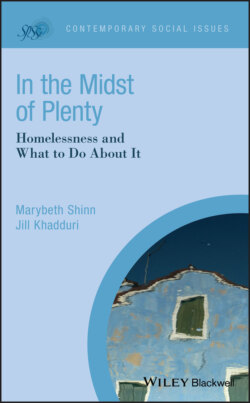Читать книгу In the Midst of Plenty - Marybeth Shinn - Страница 12
Where People Sleep: Definitions of Homelessness
ОглавлениеBy the late twentieth century, homelessness looked very different from how it appeared to Martin Luther in the sixteenth century or to researchers active between 1900 and 1980. In 1989, sociologist Peter Rossi described “modern” homelessness to distinguish it from earlier phenomena such as transient workers in the Great Depression and skid rows of family‐less working men that were still common as of the 1970s. Rossi distinguished between literal homelessness and precarious housing. Literal homelessness—living on the streets, in a car, in a bus or train station, an encampment of tents or cardboard shacks, or an abandoned building – corresponds to most people's intuitive definitions of homelessness. Europeans call this “living rough.” Rossi added those who sleep in shelters intended for homeless people. People who have access to a conventional home but may not be able to continue to stay there are precariously housed but are not literally homeless.2 The U.S. Department of Housing and Urban Development (HUD) uses essentially Rossi's definition of literal homelessness, both to determine eligibility for programs that it funds to address homelessness and to estimate how many people are homeless.3
To limit disruptions in learning that result from precarious housing situations, the U.S. Department of Education takes a more expansive view of what constitutes homelessness to determine eligibility for programs The education definition includes children and youth in families that share housing with other people because of economic hardship (often called doubling up) or who pay to live in hotels or motels because of a lack of alternative accommodations (National Center for Homeless Education, 2017). The more expansive education estimates are reported by school authorities based on answers to questions on a form submitted by parents. In this and other sources of information in the United States, it is difficult to distinguish doubled up situations that are precarious from those that are not.
Europeans have resolved the definitional complexity with a typology that enables the media, policymakers, service providers, and researchers to specify just whom they are talking about, across national borders. The European Typology on Homelessness and Housing Exclusion, with 13 categories and 24 subcategories (European Federation of National Associations Working with the Homeless AISBL, 2017), derives from a conceptual framework that considers a physical domain of housing security (having exclusive possession of an adequate space), a social domain (being able to maintain privacy), and a legal domain (having legal title to occupation). These domains permit consideration of a variety of dimensions of housing insecurity that go beyond literal homelessness, providing that the data exist to support measuring them.
In the U.S., a consensus emerged in the late 1980s that it was useful to know how many people experienced literal homelessness and who they were, in order to design policies to stem the growth of literal homelessness and ultimately end it (Khadduri, 2015). In this book, we follow that consensus, and, when we refer to homelessness, we usually mean literal homelessness in the Rossi and HUD sense. Most research on homelessness refers to some part of this group, typically those who use shelters and other homeless assistance programs, because it is relatively easy to find people in these programs, although there is some information on people who sleep rough—or, in the terminology used in the United States, are “unsheltered.”
